![]() Sonja's work in this show Latest work Sonja's Texts Page Sonja's c.v. page
Sonja's work in this show Latest work Sonja's Texts Page Sonja's c.v. page
I was born in 1960 and raised on a dairy farm
in the shadow of Mount Taranaki near the Mangawero river in New Zealand/Aotearoa.
A Māori person introduces herself by reference to the mountain and the river of their birth or their tribe, not only as a form of identification but to acknowledge the relevance of the natural world in one's cultural world.
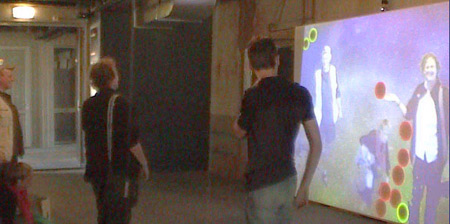
The Gardeners, 2006, an interactive projection
by Loren Roosendaal + Sonja van Kerkhoff
There are 3 short videos (one has sound) on You Tube at youtube.com/sonjavank
In my work I mix modes of discourse and present multiple stories, often related to culture and location. For example, in the interactive wall projection, "The Gardeners" (2006) made with Loren Roosendaal. The balls in the projection respond to the participant's presence, also projected in real-time on the wall, as a device for play and reflection.
The balls respond to your actions and in this way seem intelligent.
If you hold your hand out they will move towards it, but if you move too fast, they move away.
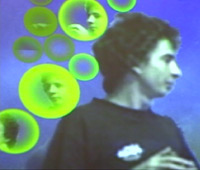
The Gardeners, 2006, an interactive projection
by Loren Roosendaal + Sonja van Kerkhoff
If a person makes 'nesting places' with their body, the balls will nestle and grow. This encourages visitors to move slowly and treat the balls affectionately.
If a participant keeps moving slowly for long enough, a snapshot of his or her face appears inside one of the balls, and it remains part of the 'memory' of the space until the next encounter with this ball.
Are resulting choreographies of interaction caused by the balls or by the participants?
Who is gardening whom?
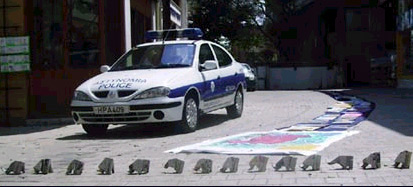
Greetings from Leiden, 2009, hour long performances
on both sides of the Cyprus Ledra Street border crossing,
south along the street and in the Büyük Han.
More photos
The performance, "Greetings from Leiden" (2009) also touches on the themes of play, reflection and power relations.
While herding origami elephants along the street or across the border dividing the Turkish-speaking part of Nicosia from the Greek-speaking part, I opened conversations with people, saying 'I am herding elephants' or 'I am bringing greetings from Leiden.'
Sometimes people engaged with me on issues such as the obvious border I was heading for and crossing, at other times they walked along the line of the elephants, treating them as objects for reflection, in the middle of a busy street, while others then had their own discussions around this growing trail.
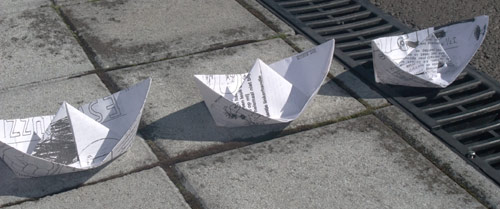
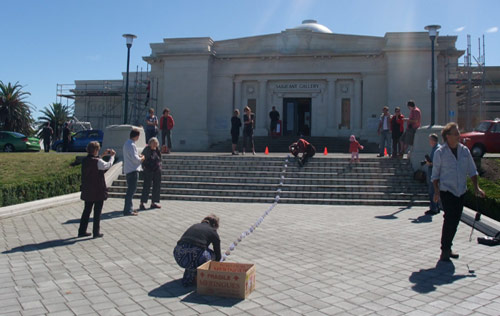
Sailing Home, 2009, Whanganui, New Zealand. Photographs: Sophie Klerk, New Zealand.
Location or relocation is another recurring theme.
Two performances, "Sailing Home" (2009) and "Colonizing Santa Monica" (2009) involved a collection of paper boats made from pages of my children's schoolbooks. These boats – signs of learning to write and learning about the world through a Dutch lens – were exposed here in the context of two English-speaking worlds.
"Sailing Home" “Sailing Home” began at the entrance of the Whanganui City Art Gallery (New Zealand) and proceeded down the steps towards the city commercial centre. In this setting it came across as a poetic intervention. But in the busy Santa Monica promenade (California, USA), it was largely interpreted as a political act, partly because I told people I was colonizing that street, and partly because, in this location, I had to constantly re-negotiate my right to be there with the police and various security officers.
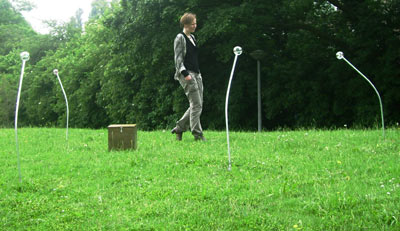
Cross Pollination, 2007,
showing 5 of the 9 'blossoms' and the 'beehive' soundbox
set-up in Leiden beforehand.
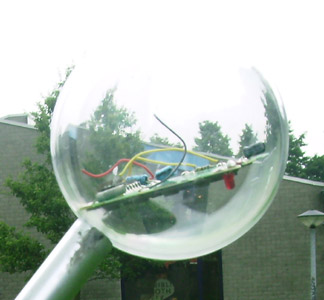
Details: Cross Pollination, a commission for
“Sculpting the Suburban Landscape”,
shown in the grounds of the
Museum of Design and Architecture, London.
More Photos
The outdoor sculpture and soundscape, "Cross pollination" (2007) was made for an exhibition in the grounds of the London Museum of Design and Architecture. It took the theme of location and relocation in reference to making and unmaking meaning out of the world around us. Sounds from a ‘beehive’ box gradually unfold from noise to a distinctive sound and then merge back into the natural sounds of this location.
Around the box, nine curved rods display small souvenir items relating to intercultural contact: a plane, a book, a model of Big Ben or a telephone box, each held in a transparent plastic ‘flower.’ The visitors walking back and forth from one to the other create a model of cross-pollination. Consciously or not, they become the bees in the metaphor as they moved from one meaning-laden object to another.
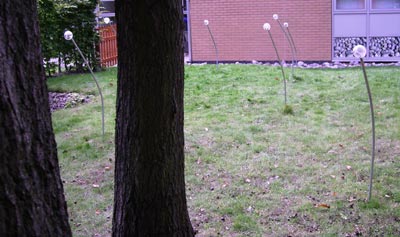
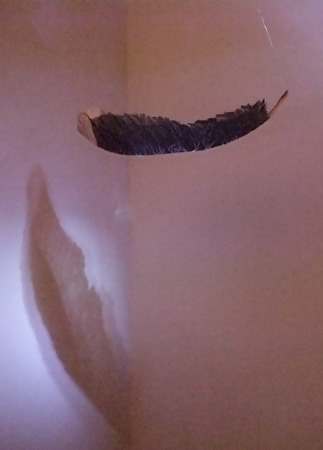
"Waka Huia" (Feather Boat) made with Sen McGlinn is a small suspended translucent vessel bearing a cargo of lightness. A cargo of the spirit. A "wakahuia" is a container for holding valuables, but this also means "feather boat" in New Zealand Maori. Our 'vessel' formed from the scan of a feather of the extinct New Zealand bird, the Huia (Heterralocha acutirostris) is combined with my drawings.
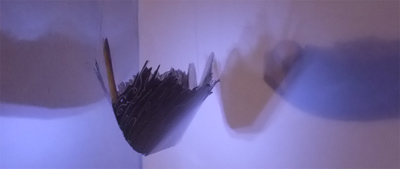
Waka Huia, 2009,
More Photos
In the video, "Heart of the Land" (2009) the journey is the location - a constant flow or relocation. I grew up in a rural farming area in New Zealand, close to the river featured in this video. The slow flow of cross-currents relates to my own upbringing and crossing between worlds.
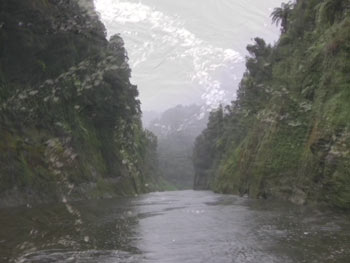
Still from the video, Heart of the Land, 2009,
4 min 22 seconds.
This video, one of five inside a 'canoe-home' that the visitor enters, is symbolically the "poutokomanawa" (referring to the heart pole of a Māori ancestral house). As they remove their shoes, feel the carpet underfoot, and find themselves surrounded in a darkened space of videos, sounds and illuminated sculptural objects, visitors should sense an active spirit
- a sense of a 'home' within.
Ehara taku kāinga i te kāinga tu tonu.
He kāinga nekeneke.
My home is not a home that stands still.
It is a home that moves.
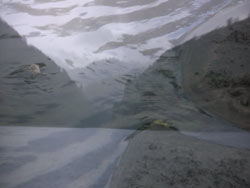
Stills from the video
The Two Lands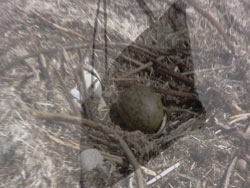
This phrase references the Maori proverb:
"Ehara taku maunga i te maunga nekeneke. He maunga tu tonu."
My mountain is not a mountain that moves around.
It is a mountain that stands still.
Here I'm saying that my identity, -my home- is on the move.
When I first visited the Netherlands in 1986, it felt as if everyone walked on concrete. I couldn't feel the land. One reason visitors will be asked to leave their shoes outside is so your feet can feel the textures of the "papa" (which means "ground" in New Zealand Māori and relates to the space on a Māori meeting ground where people have their first encounter with a tribal 'home' spiritually as well as physically. This word is also an affectionate term for mother earth).
Here my "papa" is relocated to inside a physical structure. Removing your shoes is also a small ritual visitors undergo, of removing an outer layer, before entering this 'home within' (kāinga a roto).
The work is seen through multiple viewpoints (windows or eye-holes), not only to reflect my own background as a child of a Dutch father and a Scottish-Irish New Zealand mother, as a foreigner living in the Netherlands (I moved here at the age of 29), as an artist who was raised in a working-class background, and as a mother myself, but also so viewers must choose where they stand. Each of the videos provides a differing perspective at any moment. In the spaces between the videos, shadows are projected from suspended “harakeke” (flax) container-like objects and there are localized sounds.
These serve as points for reflection, like breathing spaces between the stories in the videos. In Maori culture, baskets are utilitarian items and symbols for knowledge. Making a basket involves going into nature and making the correct selections.
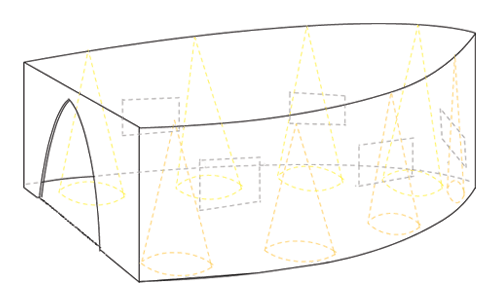
Sketch of the form showing where the five videos and the lighting will be
in the 'chapel' or 'canoe-home' Kāinga a roto (Home within).
‘Unwant’ is also about what we 'want,' about the choices we make as artists or as individuals. These videos make personal connections to my mixed pakeha (white and 'foreign white' New Zealand) rural working-class upbringing, the influences of Maori and Bahai spirituality, and chosen and unchosen consequences in relation to migration. Migration is often discussed in relation to politics, war or economics. In choosing to take a biographical approach, I am focusing on issues related to childhood, family, witnessing, and trauma in relation to the unchosen, one's UNwanted land, one's whakapapa (family history). I take land as a metaphor for the soul or self, which is why I have chosen so much water imagery. Being fluid, water flows in all directions, it cannot migrate because it is always on the move, but it can facilitate migration or a change (of heart). And a boat can go with the flow or against it. A boat as a metaphor for 'home' or 'want' foregrounds process.
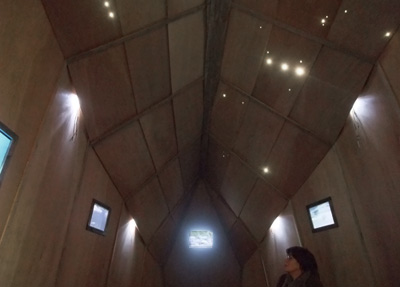
Detail of the interior
showing monitors, illuminated piupiu and the ceiling
in the 'chapel' or 'canoe-home' Kāinga a roto (Home within),
for the UNwanted Land parcous.
More photos of this work
From another perspective 'The unwanted land' is a poignant title for an examination of my childhood, because my memories are dominated by unwanted ones of pain, rejection, self-hate, and loneliness. My father was abusive and my mother coped with the trauma by switching off. I have made a number of conscious decisions to live a life not burdened by the 'unwanted.' While to some this sounds harsh, if I had not made these migrations of the heart, I would not have been able to function as an artist, perhaps not as a human being.
Initially my migration from the family home was 'unwanted' in the sense that I left, to find a job and place to live so I could continue high school. But my next major migration a few years later was a 'want.' At 19 years of age I migrated from a working class environment into the the unknown 'foreign' world of study. Even though I now live on the other side of the globe, this is still the biggest migration I've made in my life. I left the security of a job and training to go to art school. It was also a literal migration -I hitch-hiked 3000 km - but the real migration was a change of culture (of heart or mind).
The 'unwanted land' of my childhood that has always been an intrinsic part of my identity, an identity later shaped through a succession of re-locations. Because the abuses of my childhood were dramatic, I've tended to avoid dealing with them in my art, afraid they would overshadow the 'wanted land' - ideas and multi-layered stories - the magic of an artwork.
From a material perspective, the Unwanted Land exhibition is like a city, in which the scaffolding functions as a geological feature which connects all the artists. It is like a mountain ridge or a river. Here my canoe-home is positioned underneath like a shelter within a shelter, however its function is not to protect but to facilitate revelation. When a Māori person names their canoe in a mihi (introduction), they are also revealing a whole network of relationships (or positionings).
The 'position' of my work here is like a place for the spirit.
The home within then, is not so much about finding a resting place, or a 'home' to be still in, but a place for kindling/enacting a sense of the spirited. It is intended as a home that is a vessel for migration, for metaphysical motion - a home on the move.